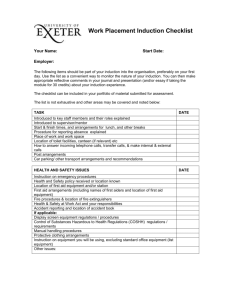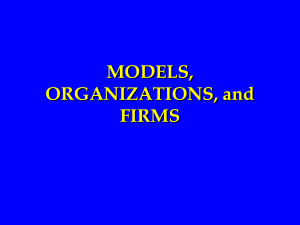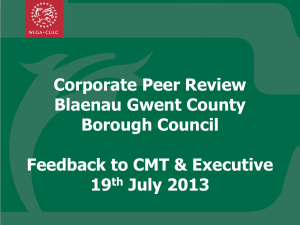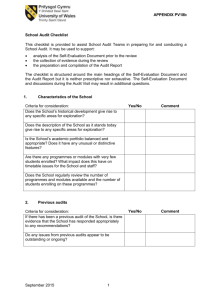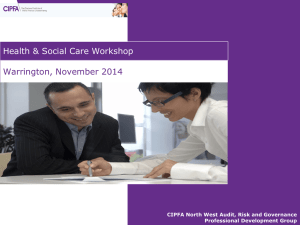Policy Implementation Checklist
advertisement
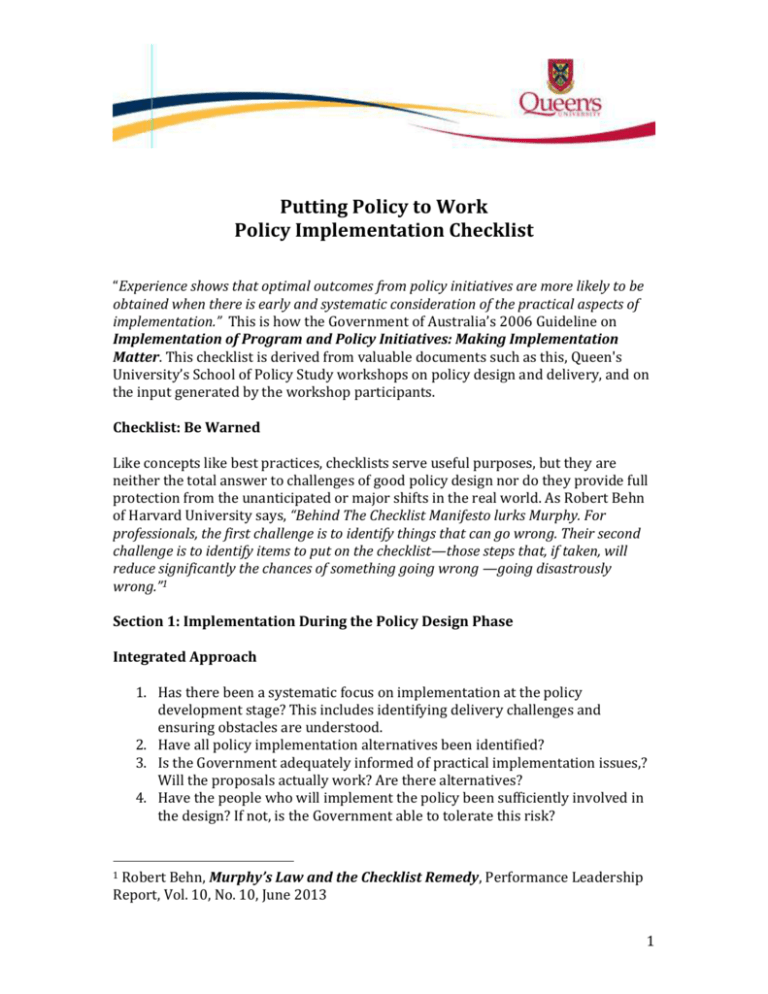
Putting Policy to Work Policy Implementation Checklist “Experience shows that optimal outcomes from policy initiatives are more likely to be obtained when there is early and systematic consideration of the practical aspects of implementation.” This is how the Government of Australia’s 2006 Guideline on Implementation of Program and Policy Initiatives: Making Implementation Matter. This checklist is derived from valuable documents such as this, Queen's University’s School of Policy Study workshops on policy design and delivery, and on the input generated by the workshop participants. Checklist: Be Warned Like concepts like best practices, checklists serve useful purposes, but they are neither the total answer to challenges of good policy design nor do they provide full protection from the unanticipated or major shifts in the real world. As Robert Behn of Harvard University says, “Behind The Checklist Manifesto lurks Murphy. For professionals, the first challenge is to identify things that can go wrong. Their second challenge is to identify items to put on the checklist—those steps that, if taken, will reduce significantly the chances of something going wrong —going disastrously wrong.”1 Section 1: Implementation During the Policy Design Phase Integrated Approach 1. Has there been a systematic focus on implementation at the policy development stage? This includes identifying delivery challenges and ensuring obstacles are understood. 2. Have all policy implementation alternatives been identified? 3. Is the Government adequately informed of practical implementation issues,? Will the proposals actually work? Are there alternatives? 4. Have the people who will implement the policy been sufficiently involved in the design? If not, is the Government able to tolerate this risk? Robert Behn, Murphy’s Law and the Checklist Remedy, Performance Leadership Report, Vol. 10, No. 10, June 2013 1 1 5. Has consideration been given to testing the options under consideration through pilot program, demonstration or lighthouse projects? 6. Has consideration been given to engaging stakeholders to identify potential barriers to implementation and possible means of addressing them? 7. Have political and operational implementation risks been clearly identified? 8. Have suitable strategies been put in place to manage any perceived conflicts of interest? 9. Has consideration been given to the priority of the initiative compared to other delivery and operational activities? 10. Is the policy fully costed with due regard to the secondary resource needs, the impacts on existing program capacity, the availability and impact on all forms of infrastructure, including information technology? Engaging Implementers During Policy Development 11. What parties will contribute to implementation and have they been involved during the policy development stage? 12. Is their input clearly communicated to decision makers? 13. Is the arrangement for service delivery clear? If not, where will practical advice on implementation issues be obtained? 14. Are the policy outcomes stated in ways that are clear to the implementers and measurable? 15. Are evaluation criteria built into the policy design? 16. What steps have been built into the policy design to ensure that implementers and stakeholders can seek adjustments as the policy moves into real world application? Clear-eyed Focus on Risk 17. Is the risk assessment sufficiently rigorous, taking into account divergent views? 18. Does the policy take into account secondary effect risks on other parts of government, e.g. added costs, threats to the smooth functioning of dependent organizations, potential policy conflict with other parts of the Government’s policy framework? Time and Timing Policy 19. Are realistic deadlines being set? Is there confidence in the timing proposed – from all parties? 20. If consideration of implementation issues was constrained during policy development, is there a plan to give these matters immediate attention? 2 21. Are deadlines, even those deliberately intended to force the pace of policy implementation, creating unintended risks? Are they raising the risk level deliberately and, if so, is this understood? Contingencies and Assumptions 22. Have contingency measures been considered? Is what is being proposed credible or testable? 23. Is the policy clear about the degree of discretion to be permitted in implementation? Alternatively, is the policy clear about those elements where there is no discretion? 24. Is there reliable data to support the implementation assumptions? If not, can it be obtained? Are alternative resources available to obtain data? Will this be done immediately or later? 25. If there are any gaps in information, what is their possible impact on implementation? Is someone offering a countervailing analysis, one that flies in the face of the most popular policy formulation? 26. Are the implementers aware of any possible risks and consequences due to gaps in information? Have they been able to voice their concerns and get answers or assurances about those risks? Section 2: Governance Commitment at the Top 27. Is there clear senior management ownership, and leadership that links policy and operations? 28. Is there a designated senior manager committed to the success of this initiative? Is that commitment in her or his performance plan? 29. Do they have the power and authority to engage all elements of the organization, develop accountabilities? 30. Do the governance mechanisms ensure that timely decisions can be made to achieve policy success? Roles and Responsibilities 31. Have the executive and key players been consulted to discuss their expectations? Are arrangements in place to ensure this alignment is regularly checked? 32. Are there organizational cultural elements that would support or hinder policy design and implementation? 33. Is there enough known about the organization culture of third party delivery 3 agents to identify and act on risk concerns? 34. Are the expectations of the executive and key players being communicated to the program manager and implementation team? 35. Does the responsible officer have the right skill set available to be effective (for example, legal, contract management or systems skills)? 36. Have the roles and responsibilities of those involved in implementation been clearly defined and articulated in a formal manner that permits monitoring, measurement and feedback? 37. Have the necessary delegations been provided to the program manager and implementation team members? Does the team fully understand the constraints – political, personal, interjurisdictional, whole-of-government – that will guide the use of their delegations? 38. Have central and delivery agencies been consulted to negotiate delivery arrangements? 39. Where third-party providers are to be used, do arrangements adequately reflect the particular risk management and governance arrangements that may arise from using such providers? What is the oversight of these arrangements? What are the information and performance needs of that oversight and how are they being met? 40. Have problem-solving and dispute resolution procedures been put in place? Whole of Government: Taking Everything Else into Account 41. Is there a common understanding among all the relevant agencies of what the initiative is trying to do, and how and when it will be done? 42. Has a lead agency been identified? 43. Does the lead agency have the authority to act in this capacity? 44. Have MOUs, agreements, contracts or committees been considered to formalize arrangements between the agencies? Mechanisms of Governance 45. Does the policy outline the governance structure beyond policy approval and through implementation? 46. Are reporting criteria clearly defined for a. reporting the status of implementation, and for b. the escalation of risks and issues to the level required? 47. Are the governance arrangements strong enough to ensure that bad news is not filtered out of reports to the executive or political leadership? 4 Section 3: Risk Management Risk Management Design 48. Is risk identification robust and agreed to by all parties? 49. Is risk identification linked directly to mitigation and potential costs of those as well as the political and organizational communications implications? 50. Is the risk management process systematic and sustained? 51. Is the risk management credible? Are those doing the analysis qualified? Does there need to be a credible third party involved? Risks in Implementing Policies through Agencies or Third Parties 52. Are the implementation risks of working with other organizations and contracted service providers adequately identified, assessed and treated? 53. Are implementation risks appropriately and explicitly shared between the organizations in a way to maximize their effective management? 54. Is there adequate accountability between the government and the agent? Is it documented what the government will have to know in order to ensure risk oversight? 55. Is there active oversight of agency performance to assure leaders in government that they will be aware of risks in a timely manner? Managing Risk and its Consequences 56. Are major areas of risk broken into manageable elements with clear accountabilities? 57. Are risks tracked and evaluated at key stages of implementation or when there are significant changes? 58. Does the policy design provide an escalation strategy when dealing with risks? This has to include scenarios where things can go very wrong. 59. Is there a contingency plan, including an exit strategy, for extremely risky initiatives? Section 4: Integrating Planning for Implementation into Policy Design Plan Early to Implement 60. Has enough time been spent on planning for implementation? Have policy assumptions been tested with potential implementers? Have scenarios been run to deal with potential pitfalls? 61. Have lessons from previous experience been drawn on? 5 62. Have experiences in other jurisdictions been sought out and studied? 63. Has consideration been given to testing the implementation at an early stage? Present a Sound Implementation Plan 64. Is the implementation plan scalable and flexible? 65. What assumptions is the implementation plan based upon and how well have they been tested? 66. Has the agency’s experience from other implementations been incorporated into this plan? 67. Does the plan provide sufficient detail to support and inform implementation? 68. Does the plan address the key elements of project management, including: timeframes, roles and responsibilities; resources; risk management; and monitoring, quality assurance and evaluation? 69. Does the implementation plan adequately reflect identified risks and how they will be managed and communicated? Whole of Government Issues 70. Is there an overarching implementation plan for cross-agency initiatives, addressing the roles and dependencies of those involved? 71. Is there clear and common understanding of key elements of shared implementation planning, including governance and decision-making arrangements; possible resource and scheduling constraints; and risk management strategies? Making it Manageable 72. Have all reasonable efforts been made to break implementation of the initiative into manageable steps?. 73. What are the risks of system overload or break-down, often in unanticipated ways, due to the cumulative effect of several changes? 74. Do milestones reflect appropriately significant and assessable deliverables at each stage? 75. Do milestones address the interactions and dependencies of concurrent or parallel activities? 76. Is there sign-on with these milestones, especially from those who have to meet them? 77. Are there sufficient review points so that the project can be amended, or even stopped, if necessary? 6 Plan to Adapt 78. Is there a clear understanding that events will not unfold completely as expected, errors will occur and policy application may be subject to localization, often without intention? 79. Are there procedures to assess the need for and manage changes to the plan, including appropriate high‑level sign-off? 80. Are there mechanisms to resolve emergent issues on a rapid basis? 81. Has adequate attention been given to minimizing the occurrence of system changes late in the implementation cycle? Section 5: Communications Developing a communication strategy 82. Is the communication strategy clearly aligned with implementation’s success factors? 83. Has there been appropriate senior management input? 84. Is the communication strategy supported by stakeholder analysis? 85. Is the communication strategy aligned with stakeholder needs? Making communication an integral part of implementation 86. Is the communication strategy reflected in the implementation plan? How will it be reviewed and updated during the implementation cycle? 87. Does the timing of key messages link to implementation milestones? 88. Are the needs of all stakeholders reflected in the communications strategy? 89. Does the communication strategy provide for stakeholder feedback? 90. Are resources targeted to maximize the necessary messages to all stakeholders? Section 6: Monitoring and Review Monitoring the Initiative during Implementation N 91. Has monitoring and review been considered as part of implementation planning? 92. Are monitoring and review arrangements a realistic use of available resources? 93. Are there arrangements to ensure consistent, high-quality and appropriate frequency of monitoring? 7 94. Are monitoring arrangements linked to the critical implementation risks? 95. Are monitoring and review arrangements aligned with external requirements? Review of Progress and Initiating Any Corrective Action 96. Do information systems support the provision of timely data? If not, what is being done to address this? 97. Is there an effective escalation strategy to deal with warning sign performance data? 98. Is there integrated and systematic tracking? Whole-of-Government 99. Is there a shared understanding of the different reporting roles and responsibilities? Is this documented? 100. Is there compatibility of data across agencies? If not, what is needed to provide meaningful progress reports? 8
